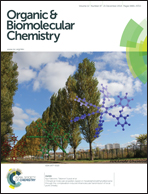Facile diverted synthesis of pyrrolidinyl triazoles using organotrifluoroborate: discovery of potential mPTP blockers†
Abstract
This article describes the rapid and diversified synthesis of pyrrolidinyl triazoles for the discovery of mitochondrial permeability transition pore (mPTP) blockers. The 1,3-dipolar cycloaddition of ethynyl trifluoroborate with azidopyrrolidine produced a key intermediate, triazolyl trifluoroborate 4, which subsequently underwent a Suzuki–Miyaura coupling reaction to afford a series of 1,4-disubstituted triazoles 2. Subsequent biological evaluation of these derivatives indicated 2ag and 2aj as the most potent mPTP blockers exhibiting excellent cytochrome P450 (CYP) stability when compared to the previously reported oxime analogue 1. The present work clearly demonstrates that a 1,2,3-triazole can be used as a stable oxime surrogate. Furthermore, it suggests that late-stage diversification through coupling reactions of organotrifluoroborates is suitable for the rapid discovery of biologically active molecules.


 Please wait while we load your content...
Please wait while we load your content...